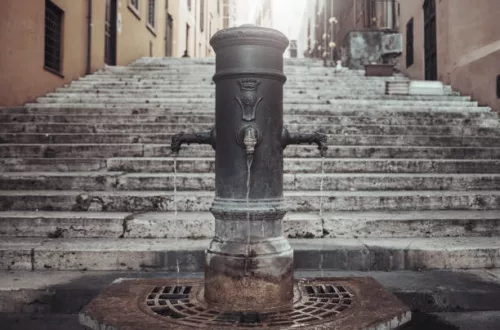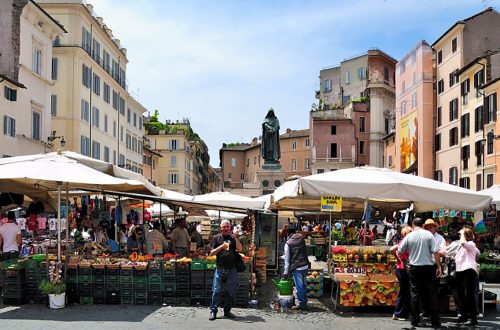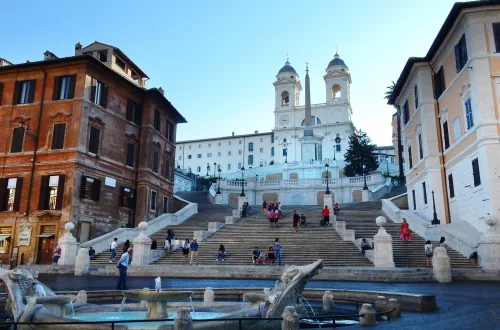
Fontana dei Quattro Fiumi
Piazza Navona:
Piazza Navona is a large and vibrant square in the heart of Rome. It is a quintessential example of Baroque architecture and urban planning. The square’s design is built upon the ancient Stadium of Domitian (also known as the Circus Agonalis), which was constructed in 86 AD. The stadium was used for athletic competitions, but over the centuries, it was transformed into a public square.
The square’s elliptical shape is a reminder of the original stadium’s layout. Over the centuries, the area around Piazza Navona has developed into one of Rome’s busiest and most popular spaces, attracting locals and tourists alike.
The square is known for its vibrant atmosphere, with street artists, musicians, cafés, and restaurants. The beautiful architecture of the surrounding buildings, such as the Church of Sant’Agnese in Agone (designed by Francesco Borromini) and the Palazzo Pamphilj, adds to the grandeur of the space.
Piazza Navona’s central feature, of course, is its three beautiful fountains:
Fountain of the Four Rivers (Fontana dei Quattro Fiumi):
This stunning fountain was designed by Gian Lorenzo Bernini and unveiled in 1651. It is one of Bernini’s most famous works and stands as a masterpiece of Baroque sculpture and engineering.
Symbolism of the Four Rivers:
Each of the four rivers represented in the fountain symbolized the most important rivers of the known world at the time:
-
The Nile (representing Africa):
-
The figure of the Nile is depicted as a reclining man with a veil over his head, symbolizing the mystery of the river (since its source was not known to Europeans at the time). The figure holds a reed, which is a nod to the river’s role in nourishing the land.
-
-
The Ganges (representing Asia):
-
The Ganges is represented by a powerful figure with a raised arm, symbolizing the river’s importance to Asia. The figure also holds a jar, from which water flows, representing the life-giving aspect of the river.
-
-
The Danube (representing Europe):
-
The Danube is depicted as a strong, muscular man, holding a shield with the arms of the Habsburg family (which ruled over much of Europe at the time). The figure’s pose reflects the river’s sweeping reach through Europe, and he gazes upwards, signifying strength and presence.
-
-
The Rio de la Plata (representing the Americas):
-
The Rio de la Plata is symbolized by a man holding a pile of coins in his hand, signifying the wealth brought by the Spanish colonies in the Americas. He also looks towards the distance, symbolizing exploration and discovery of the New World.
-
Obelisk and Structure:
The obelisk at the center of the fountain adds an Egyptian touch to the composition. The obelisk is a Roman addition, having been brought to the fountain from the nearby Circus of Maxentius. It stands at a height of about 16 meters and serves as a symbol of Rome’s ancient connection to Egypt, a key influence during the Roman Empire.
The fountain is arranged in a circular shape, with the four river gods arranged at the corners. The entire structure is surrounded by intricately designed rocks, plants, and water, creating a dramatic sense of movement and flow. The water jets from the figures also contribute to this dynamic effect.
Additional Sculptural Details:
Around the base of the fountain are various decorative elements:
-
Dolphins: Representing speed and the flowing nature of water.
-
Leopards: The sculptor positioned them to symbolize the exotic and dangerous animals that were brought to Rome in ancient times.
Historical Context:
The Fountain of the Four Rivers was commissioned by Pope Innocent X, a member of the Pamphili family. The family’s palace, Palazzo Pamphilj, sits on the square, and this fountain was built to commemorate both the family’s wealth and power as well as the pope’s role in shaping Rome.
In addition to its grandeur, the fountain was part of an effort to beautify Rome during the Baroque period, which was characterized by dramatic art, architecture, and urban design. The Baroque style in Rome was in full swing during this time, and the Fountain of the Four Rivers reflects the era’s emphasis on movement, emotion, and contrast.
The Fountain of the Four Rivers is also a symbol of the power of the Catholic Church and the papacy. The four rivers, representing the four corners of the world, also symbolized the spread of Christianity and papal authority throughout the world.
Other Notable Features in Piazza Navona:
-
Church of Sant’Agnese in Agone:
-
Designed by Francesco Borromini, the church was built in honor of Saint Agnes, who was martyred on the site of the stadium. The church’s dome and dramatic façade contribute to the overall Baroque aesthetic of the square.
-
-
Fountain of Neptune:
-
At the northern end of the square, this fountain, designed by Giovanni Bologna, depicts Neptune battling a sea monster. It represents the triumph of the sea and is a complementary feature to the Fountain of the Four Rivers.
-
-
Fountain of the Moor:
-
This fountain, designed by Giovanni Lorenzo Bernini’s pupil, Antonio Morandi, features a statue of a Moor struggling with a dolphin. It is located at the southern end of Piazza Navona, providing a contrasting but equally impressive centerpiece.
-
Modern Significance:
Today, Piazza Navona remains a cultural hub, attracting visitors from around the world. It hosts a variety of events, including Christmas markets, musical performances, and art exhibitions. The square, with its fountains, churches, and palaces, continues to be a stunning example of the blend of history, art, and architecture in Rome. It is often considered one of the most beautiful squares in Rome, if not the world.
This fountain and the surrounding piazza truly encapsulate the grandeur of Baroque Rome and the historical significance of the city during the Renaissance and Baroque periods. Have you had a chance to visit Piazza Navona?
![]()




